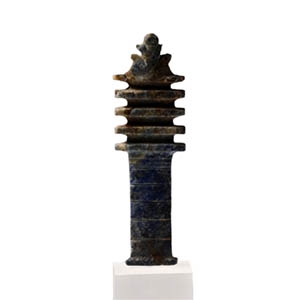Home > Auctions > 26 November - 1 December 2024
Ancient Art, Antiquities, Natural History & Coins
with Archeological Centre, 2015.
Private collection, Europe.
Cf. Ben-Tor, D., Scarabs, Chronology, and Interconnections: Egypt and Palestine in the Second Intermediate Period, Zurich, 2007, p.176, for discussion of this scarab type, and pl.99, no.9, for an example.
Scarabs with this design have been discovered in the northern Delta of Egypt and Palestine. The influence of the crocodile god Sobek on the production of late middle Bronze Age settlers at Avaris in the Egyptian Delta likely contributed to the popularity of Egyptian-themed scarabs with crocodiles and standing figures found in Palestinian sites.
Acquired in the mid 1980s-1990s.
Private collection, Switzerland, thence by descent.
Private collection, since the late 1990s.
Private collection Mr E. Saad, Cairo, Egypt-Montreux, Switzerland, 1970s.
Ex private collection of Mr S.A., acquired from Mr Saad in 1997.
In ancient Egyptian mythology, Isis was the sister-wife of Osiris and the mother of the sky god Horus. She is associated with aspects of fertility and motherhood. This amulet unusually depicts her with a two-plumed crown, which may associate her with the goddess Sothis.
From the collection of a gentleman, acquired on the London art market in the 1990s.
In Egyptian mythology, Thoth restored the eye of Horus, suggesting that this may be the theme of the figurine's composition. Alternatively, the composition may be a condensed depiction of the funerary vignette, which shows the falcon form of the sun god Re in his solar barque flanked by baboons in an attitude of praise. The slot in the underside suggests it was once attached to a separate base.
From the collection of a gentleman, acquired on the London art market in the 1990s.
Cf. Reisner, G.A., Catalogue général des antiquités égyptiennes du Musée du Caire, Nos.5218-6000 et 12001-12527, Vol. I, Amulets, Cairo, 1907, p.158 (no. CG12263) and pl.XX, for a smaller amulet of a similar format.
This represents a condensed version of a two-dimensional funerary scene of the sun god Re, here represented by the horned disc, in his solar barque, flanked by baboons in an attitude of praise. The boat's ram-headed prow possibly alludes to Re's transformation into a ram during his night-time journey through the Underworld.
Ex R. Liechti (1934-2010) collection, Geneva, Switzerland.
Private collection, Europe.
This lot has been checked against the Interpol Database of stolen works of art and is accompanied by search certificate number no.12365-226680.
Cf. Roeder, G., Ägyptische Bronzefiguren II, Berlin, 1956, fig.201 and pl. 25a-c, for a similarly decorated figure.
Osiris is a deity who represents death and fertility and is commonly regarded as the quintessential god of rebirth. Though he was once a mortal ruler, as a deceased entity, his domain was the Underworld. Abydos was the primary centre of Osiris’ cult, where a renowned yearly celebration of the god was held. The proliferation of bronze statues of the god indicates his widespread popularity. R. Liechti was a distinguished collector of Egyptian antiquities, known for his discerning eye and passion for ancient artefacts. Active during the mid-20th century, Liechti's collection featured a wide range of objects that showcased the rich cultural heritage of ancient Egypt, from intricately carved statuettes to rare amulets and jewellery. His dedication to preserving and studying these relics earned him a respected reputation among scholars and collectors alike. Many pieces from his collection have since found their way into prominent museum collections and auction houses, further solidifying his legacy in the world of antiquities.
Ex pre-war collection, Switzerland.
Private collection, Europe.
Accompanied by a copy of an Art Loss Register certificate no.S00075707.
This lot has been checked against the Interpol Database of stolen works of art and is accompanied by a search certificate number no.12371-226682.
Cf. Roeder, G., Ägyptische Bronzefiguren II, Berlin, 1956, pl. 21c-d, for a similar example.
Harpocrates is the Greek rendering of the Egyptian Hor-pa-khered, which translates as 'Horus the Child'. This refers to Horus as the divine infant of Isis and Osiris. Statuettes of Harpocrates could provide the dedicator with the same protection that Isis gave her beloved son.
Acquired on the German art market, 1989-1995.
with The Museum Gallery, 19 Bury Place, London, WC1, UK, 1998-2003.
Property of a London based academic, 2003-present.
Cf. Tinius, I., Altägypten in Braunschweig. Die Sammlungen des Herzog Anton Ulrich-Museums und des Städtischen Museums, Wiesbaden, 2011, p.107, no. 161, for a similar example from Aswan.
Osiris is a deity who represents death and fertility and is commonly regarded as the quintessential god of rebirth. Though he was once a mortal ruler, as a deceased entity, his domain was the Underworld. Abydos was the primary centre of Osiris’ cult, where a renowned yearly celebration of the god was held.
German art market.
European private collection, 1970s-early 2000s.
Acquired from the above; thence by descent.
Private collection, London, UK.
Accompanied by an academic report by Dr Raffaele D’Amato.
This lot has been checked against the Interpol Database of stolen works of art and is accompanied by search certificate number no.12348-225588.
Cf. Lacovara, P. et al., The Collector’s Eye: Masterpieces of Egyptian Art from The Thalassic Collection, Atlanta, 2001, for a sistrum with a Bes figure incorporated into the handle; see a late Egyptian prototype of a bronze sistrum with handle in the shape of the god Bes, 30th Dynasty, c. 350 B.C. (Neues Museum, Berlin); see a Roman sistrum in MET, accession no.97.22.2; a bronze sistrum, in the British Museum, inv.no.1756,0101.541; Daremberg, C.V. & Saglio, E. (eds.), Dictionnaire des Antiquités Grecques et Romaines, Paris, 1873-1917.
The sistrum (seshesh in ancient Egyptian) was a rattle-like musical instrument, played exclusively by women in religious ceremonies. It was often decorated with the bust of the goddess Hathor to whom the sistrum was sacred. Their use continued into the Roman period in ceremonies associated with the cult of Isis.
Old French family collection of Monsieur and Madame D., 1960s.
Ex Rennes Enchères, Hôtel des Ventes, France, 11 March 2003, no.117 (front-cover) for 150,000.00 euros.
Acquired from Mansour Gallery, London W1, UK, in 2013.
From the collection of a Kensington gentleman.
Private collection, UK.
Accompanied by the original Rennes Enchères catalogue.
Accompanied by a copy of French passport no.058205 dated 15 April 2003.
Accompanied by a copy of Mansour Gallery’s invoice, 2013.
Accompanied by previous typed and illustrated collection cataloguing pages.
Accompanied by an academic report by Egyptologist Paul Whelan.
This lot has been checked against the Interpol Database of stolen works of art and is accompanied by a search certificate number no.12372-225585.
Cf. Roeder, G., Ägyptische Bronzefiguren, Berlin, 1956, p.471.
Francesc Cambó i Batlle (1876-1947) a prominent Spanish politician, art patron and philanthropist.
Gifted to his friend, the archaeologist Josep Gilbert i Buch.
Acquired from Gilbert's family by the present owner's grandfather in the early 1980s.
Private collection of a European noble.
Cf. Rijksmuseum van Oudheden, Leiden, inv.no.F1995/5.4, for an offering cup from Kafr el-Gebel, Giza; Vandier d’Abbadie, J., Les objets de toilette égyptiens au Musée du Louvre, Paris, 1972, p.129, no. 557, for the shape.
Francesco Cambó i Batlle was a notable figure in early 20th century Spain, best known for his role in politics as a leader of the Catalan nationalist movement and as a patron of the arts. He was a key benefactor of the Museo del Prado and left a significant legacy through his art collections. His deep connection to the cultural and artistic life of Spain makes items from his collection particularly valuable and historically significant.
Ex R. Liechti (1934-2010) collection, Geneva, Switzerland.
Private collection, Europe.
Cf. National Museums Liverpool, accession no.M11918a, for a later example in lapis lazuli.
The djed pillar signifies the concepts of 'enduring' and 'stability' and was a common funerary amulet from the Old Kingdom onwards. It was first associated with the gods Ptah and Sokar but later became a symbol of Osiris, representing the god's backbone. In this context, the djed pillar appears in Chapter 155 of the Book of the Dead, concerned with the deceased's resurrection. R. Liechti was a distinguished collector of Egyptian antiquities, known for his discerning eye and passion for ancient artefacts. Active during the mid-20th century, Liechti's collection featured a wide range of objects that showcased the rich cultural heritage of ancient Egypt, from intricately carved statuettes to rare amulets and jewellery. His dedication to preserving and studying these relics earned him a respected reputation among scholars and collectors alike. Many pieces from his collection have since found their way into prominent museum collections and auction houses, further solidifying his legacy in the world of antiquities.
13 - 24 of 3419 LOTS


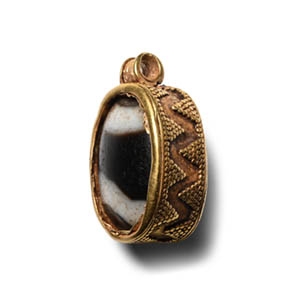
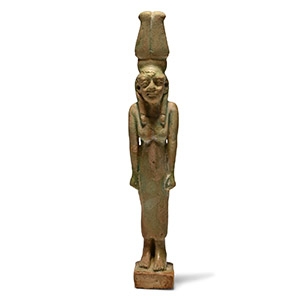
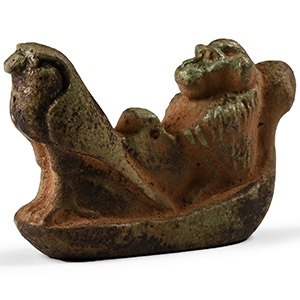

.jpg)
.jpg)
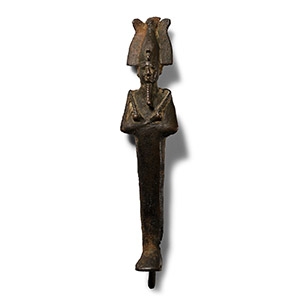
.jpg)
.jpg)
.jpg)
